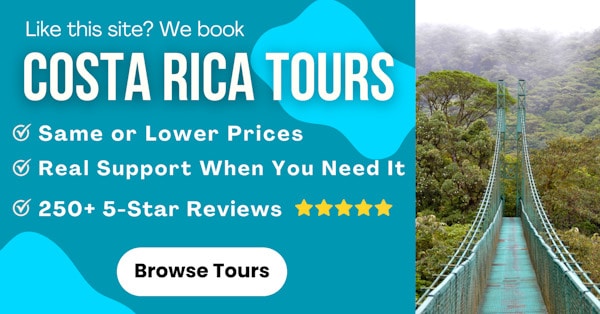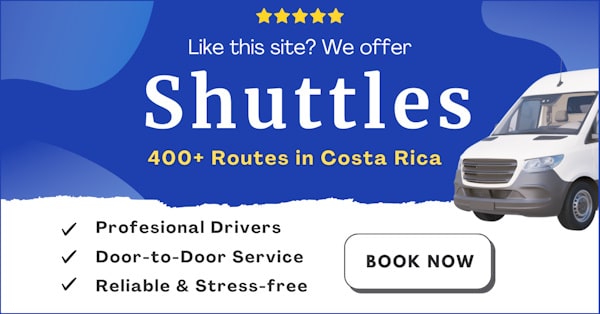Last Updated: August 1, 2025
Surfing is definitely the number one water sport in Costa Rica. And while we have lived here for many years, we’ve only tried it a couple of times. With our kids getting older, though, we’ve found that learning to surf as a family can be really fun. In this post, we’ll share our experience taking surf lessons in Uvita and tell you why it’s a great place to start.
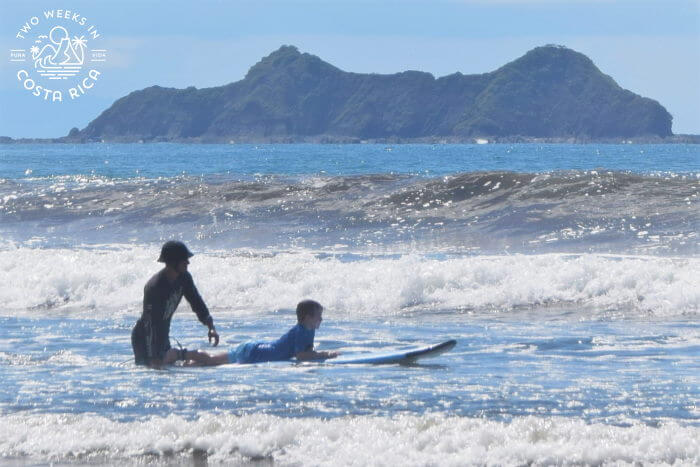
Why Uvita is Good for Surfing
Costa Rica has hundreds of surfing beaches and Uvita is, of course, not the only place to find great conditions. However, there is something special about this spot.
The Uvita area is most famous for what is known as the Whale Tail. This is a giant sandbar jutting off the coast. From above, it is shaped just like a tail.
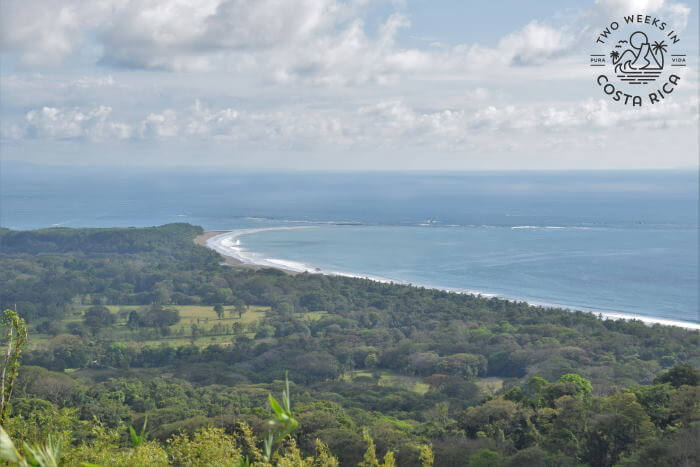
The rocky formation collects sand and distributes it onto the tail itself and along the adjacent beaches.
To the north of the Whale Tail is Playa Hermosa de Uvita. This beach, like nearby Dominical, is popular among intermediate and more advanced surfers.
But just south of the main beach (Playa Uvita) is Playa Chaman. Playa Chaman has sandbars offshore that create consistent rolling waves. At most tides they aren’t too big but still have a strong pushing momentum that is great for learning to surf.
This is where our lessons started.
Gearing Up
We met up with our surf instructor, Gabriel, near the entrance of Marino Ballena National Park. He told us that we’d be driving down the road a bit (to the Playa Chaman entrance) where conditions were ideal.
Gabriel already had the surfboards, cooler, and rash guards loaded on his vehicle and told us to follow him.
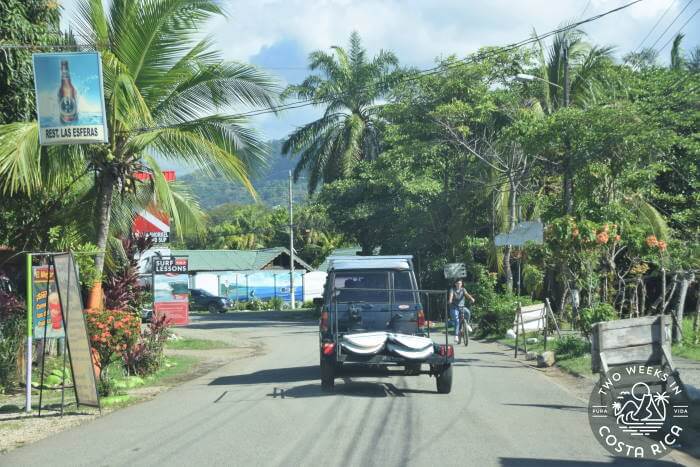
Once we parked the car, showed our national park tickets (provided by the tour company), and walked to the beach, we were ready to learn.
For today’s tour, it would be Sam (7 years old) and me (Matt) taking the lesson. This would be the second lesson for both of us, but first time doing a lesson together.
To learn about when Sam and Jenn did their first surf lessons in Guanacaste, read the post, Family-Friendly Surf Lessons in Playa Grande. You can also find some surf lessons that we offer on our Tours page in places like Samara, Tamarindo, and Jaco.
Introduction and Refresher
Since it was a hot and sunny day, Gabriel kept us in the shade of the palm trees at first. Here we discussed what we would be doing. He also asked us questions about our previous surfing experience.
Drawing some lines in the sand with a stick and then laying right on his belly, Gabriel reminded us how to lay on the surfboard, paddle with our arms, and pop up in the right position. His brief but concise directions sparked memories for both Sam and me of our past lessons.
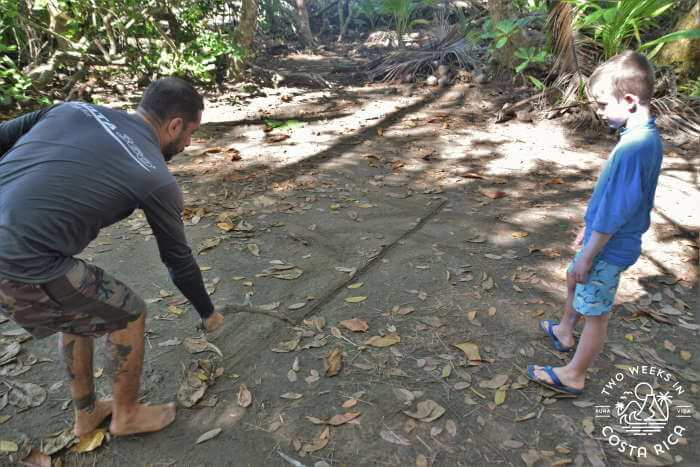
Next it was our turn. Sam and I both laid down on the sand and tried to mimic the moves that our instructor had showed us. To be honest, it wasn’t pretty.
After some laughs and more tries, we were getting the hang of it. Gabriel corrected a few wrong moves and seemed happy with our skills.
Tip: If you are traveling with your family, be sure to check out our Costa Rica with Kids page.
Learning to Turn
“Today you guys are going to learn how to turn,” Gabriel said as he got back in front of us. “Since you have already surfed, I know you can do it!”
Sam and I both smiled and got excited. We hadn’t expected this, but it made sense that it was the next step in learning to surf.
Gabriel went on to show us how to keep crouched down on the surfboard. “Then to turn,” he said, “you lean down and touch the board here,” pointing to a spot between his feet. “This shifts your weight and makes you turn. Now you try it.”
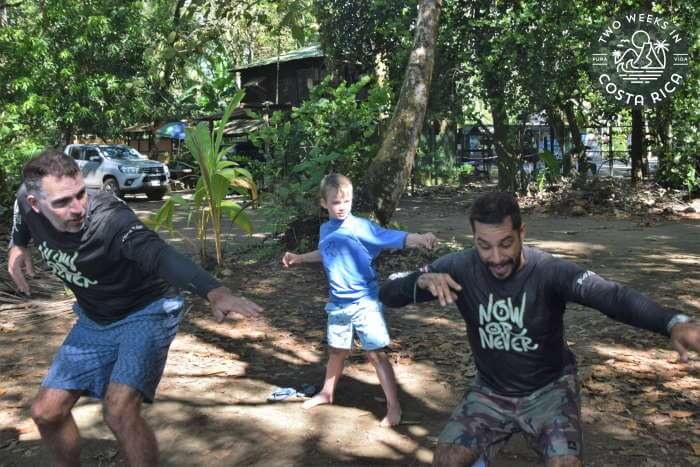
Sam and I both practiced and were eventually coached into the right positions.
“Ok guys, let’s hit the water. You are ready!” Gabriel said.
Taking on the Waves
Carrying our surfboards down to the water’s edge, we looked out at the amazing view along Playa Chaman. Behind us was a thick row of palm trees. In front of us was the sparkling ocean with small islands offshore.
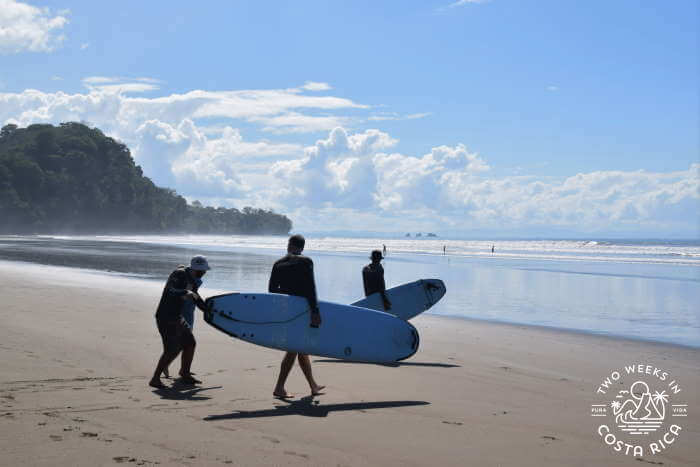
The tide was low but coming in as we got up to waist deep and listened to Gabriel’s instructions. He was with me, and an assistant named “T” was helping Sam.
Laying on the boards, we paddled out, guided and pulled by our instructors.
Soon it was time to take on the waves. T swung Sam’s surfboard around as a nice wave of whitewater swooshed in. The whitewater is a second wave that forms after the larger original wave has already crashed in the deeper water.
Pushed a bit by T, Sam got some momentum from the whitewater and popped right up on his board. He rode the wave about 20 feet (6 meters) and then plopped into the shallow water.
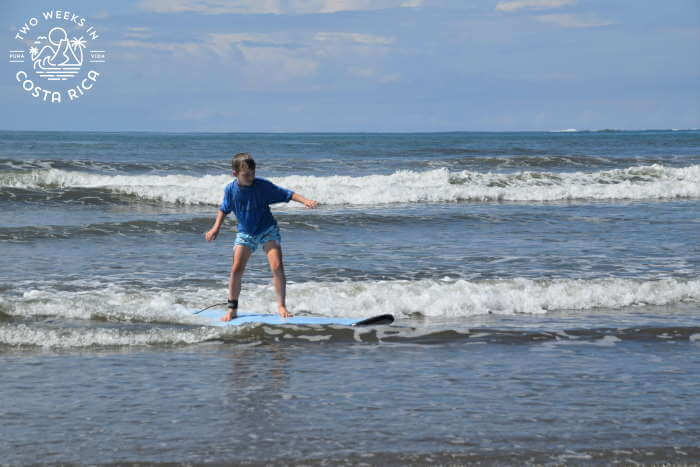
Now it was my turn. Gabriel eyed a wave coming in, helped me turn the board toward the shore, and gave me a little push. “Paddle, paddle, paddle!” he called out.
I dug my hands into the water and paddled hard. I immediately felt the momentum of the wave propel me forward. I popped up, standing in a sideways position and awkwardly gained my balance, then surfed in toward Sam and jumped off the board next to him.
Turning the Board
The plan was to have us practice popping up and surfing in a straight line for a while until we got the hang of it. To everyone’s surprise, Sam, on his second try, leaned down like we were instructed on the shore and turned his board!
Gabriel shouted and clapped in excitement and my jaw dropped.
Eventually I was able to turn on some of my tries too. We were each having fun and learning a lot.
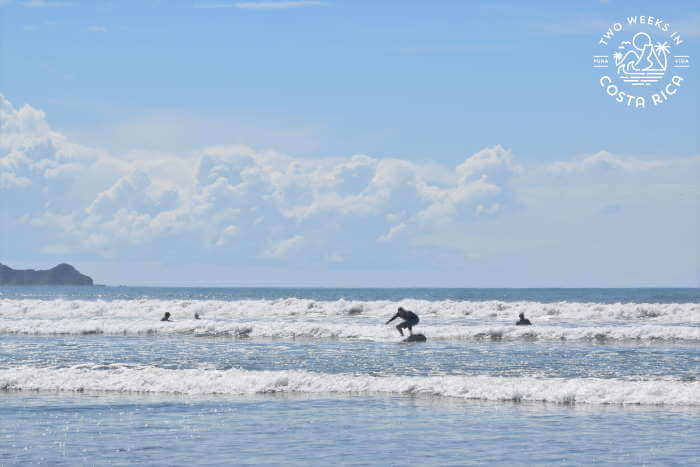
Green Waves
After a short break on the sand with some fresh fruit and cold drinks, Gabriel took us back out to the water. This time we were looking to catch “green waves” he told us.
A green wave is an unbroken wave. Since we were in the whitewater before (area with waves that had already crashed), this meant going out a little deeper to catch the wave where it breaks the first time.
I could tell this was going to be a big challenge for both Sam and me, but we were ready to try. Luckily our instructors were there to help us.
As we waited for the ideal wave to come, Gabriel told me about how a lot of surfing is being patient. “If you chase after every wave, you will wear yourself out,” he said.
We watched as T eventually set up Sam for a green wave. T helped guide him into the right position and pushed him a little to gain some forward momentum. Sam popped up on the board, rode it for a second, and then crashed hard into the water. He came up to the surface quickly, smiling and looking to try again.
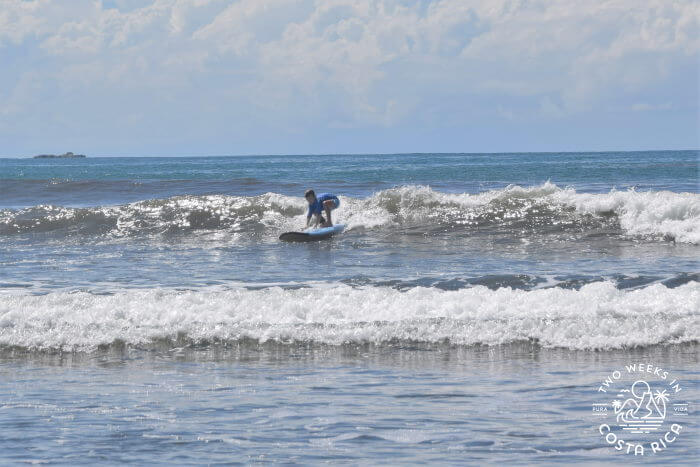
My first attempts at green waves went a lot like Sam’s. Eventually though, we each caught one. Catching the green wave had a much different feeling. There was a lot more strength behind the wave and that gave us more speed on the board.
Gabriel worked with me on catching some more green waves while T did the same with Sam. This one-on-one instruction was priceless.
Reading Waves and Picking a Direction
I laid on the surfboard in the deeper water and Gabriel stood with me, up to his chest. He spent a lot of time explaining what each wave was doing and why it was either good or bad. He was teaching me how to read the waves.
Some waves were cresting too far out, others were either too small or too big. Even more were just a little off, cresting near us but not in the exact right spot. Again, patience was the key.
Gabriel helped me catch four or five good green waves. He taught me which direction they were going (left or right) and how to turn into them. I wasn’t doing it perfectly, but I was learning each time.
With our tour time ticking toward the end, Gabriel wanted to see me catch a green wave all on my own. He wouldn’t push or pull me into the right spot. I had to paddle and get the timing right myself.
This took a while, maybe 10 attempts, but I finally caught one. The feeling was amazing. I was hooked, and I could tell Sam was too.
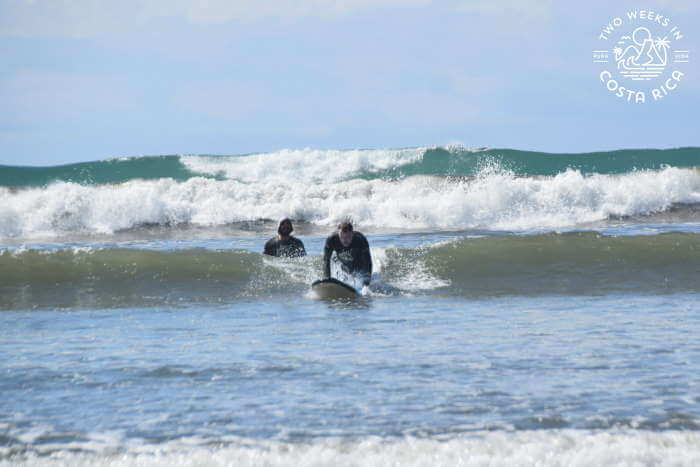
Wrapping up Our Uvita Surf Lessons
After a couple of hours surfing, Sam and I were tired and ready to visit some good restaurants in Uvita. Surfing was hard. It was a lot of exercise, and we had been beaten up by many waves. However, we both loved it. The feeling of catching a wave, gaining speed, and even turning was a real rush for us both. We will definitely be doing more surf lessons and renting boards in the future. Hopefully our experience has also inspired you to give it a try.
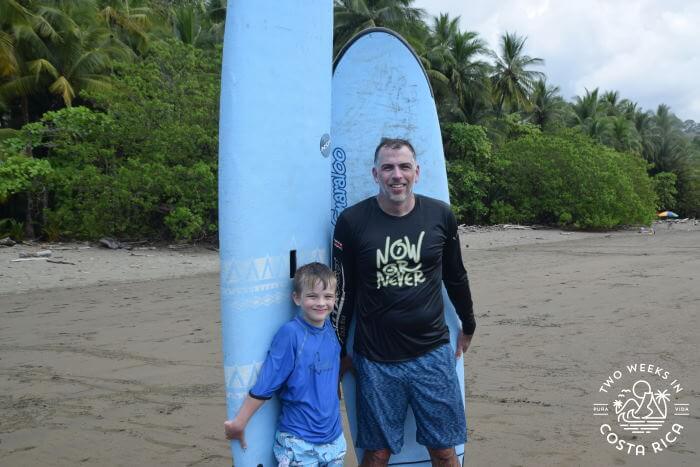
Have a question about surf lessons in Uvita or want to share your experience? Leave us a comment below.
Looking for more information to help you plan your trip? Check out these posts:
Things to Do in Uvita – This post has both popular and lesser-known activities in Uvita. We especially loved the “Coconut Man’s” tour.
Uvita Tours – See the tours we book in the Uvita area and other destinations around Costa Rica.
Playa Ventanas: A Beach with Caves – This beach near Uvita has cool caves that you can walk into at low tide.
Things to Do in Dominical – If you’re in the Uvita area, Dominical is just up the road. Check out even more fun stuff here!
Rental Car Discount – Exploring the Uvita area is best done with a rental car since things are spread out. Get 10% off from one of the best companies in the country, plus free extras.
Ocean Activities – Looking for other fun water activities? This category has boat tours, different surf experiences, and more. Or visit our Things to Do category to browse all 150+ articles.


